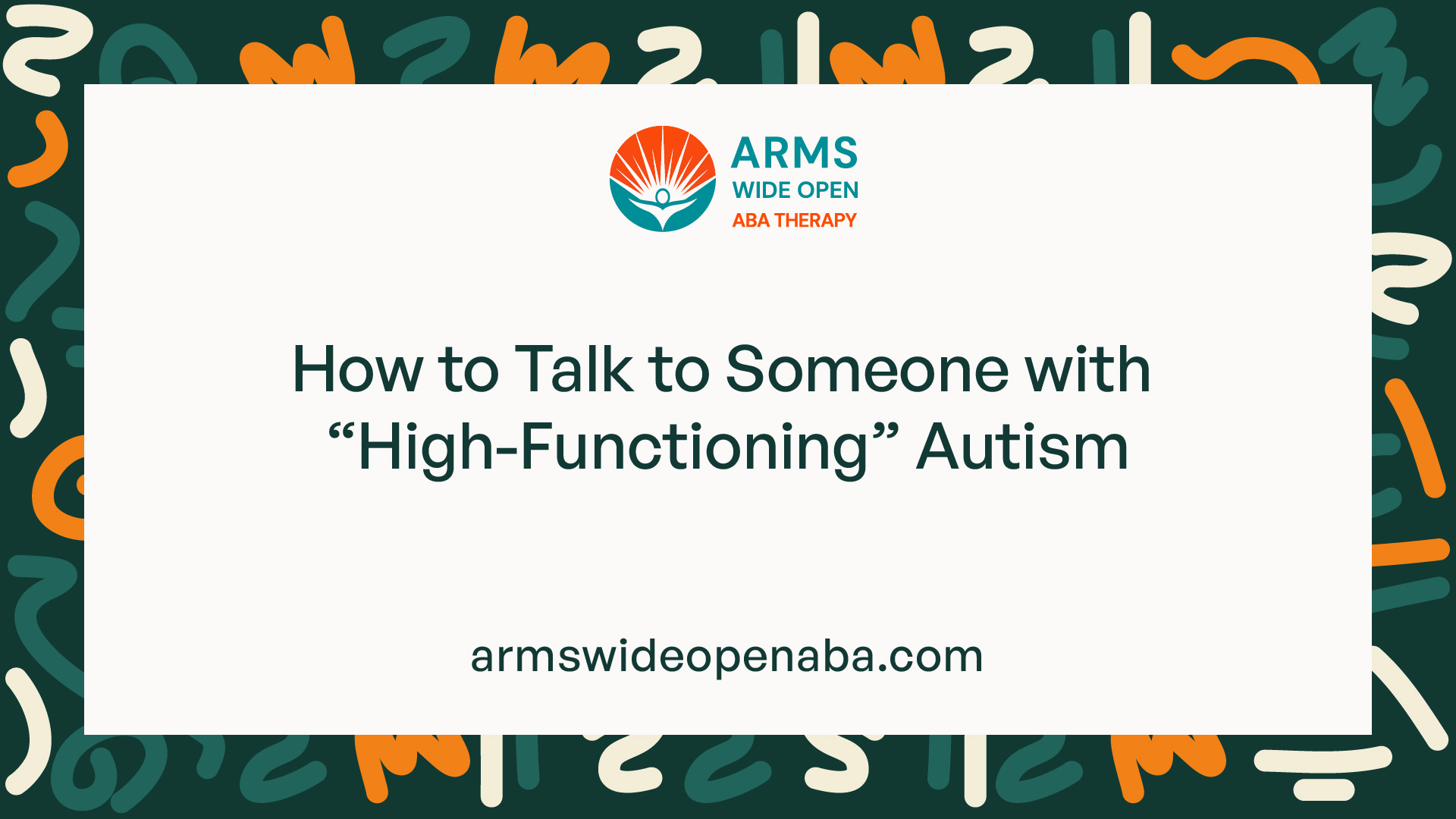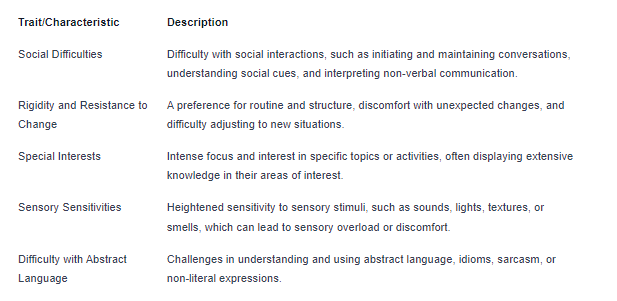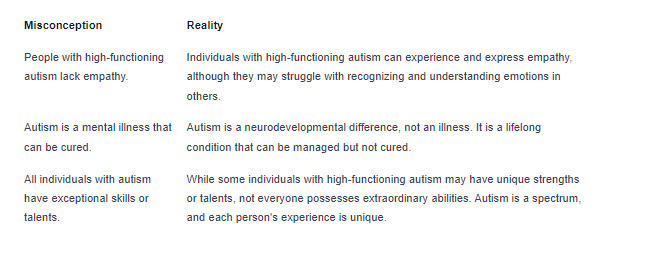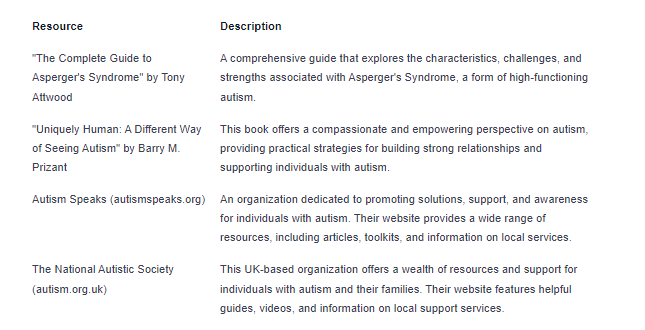How to Talk to Someone with “High-Functioning” Autism
Connect with individuals with high-functioning autism through empathy and understanding. Learn effective communication tips and create a supportive environment.

Understanding High-Functioning Autism
To effectively communicate and connect with individuals with high-functioning autism, it's essential to have a basic understanding of what high-functioning autism is and the common traits and characteristics associated with it.

What is High-Functioning Autism?
High-functioning autism is a term used to describe individuals on the autism spectrum who have average or above-average intelligence and language abilities. While autism is a spectrum disorder, high-functioning autism specifically refers to individuals who exhibit fewer cognitive and language impairments compared to those with other forms of autism.
It's important to note that the term "high-functioning" does not diminish the challenges faced by individuals with autism but rather highlights their specific abilities and strengths. Every individual with high-functioning autism is unique, and their experiences and abilities may vary.
Common Traits and Characteristics
Individuals with high-functioning autism often exhibit certain traits and characteristics that can influence their communication and social interactions. It's important to remember that these traits may manifest differently in each individual. Some common traits and characteristics include:

Understanding these common traits and characteristics can help foster empathy and create a more supportive environment for individuals with high-functioning autism. By adapting our communication strategies and being mindful of their unique needs, we can establish meaningful connections and promote understanding.
Communicating with Individuals with High-Functioning Autism
When interacting with individuals with high-functioning autism, effective communication plays a crucial role in fostering understanding and connection. Understanding the importance of empathy and employing specific communication strategies can make a significant difference in building positive relationships.
Importance of Empathy and Understanding
Empathy is a fundamental aspect of communicating with individuals with high-functioning autism. By putting yourself in their shoes and seeking to understand their perspective, you can create a supportive environment that encourages open and meaningful communication.
It's important to recognize that individuals with high-functioning autism may have unique ways of processing information and expressing themselves. By approaching conversations with patience, compassion, and a non-judgmental attitude, you can create a safe space where they feel valued and understood.
Tips for Effective Communication
When communicating with individuals with high-functioning autism, consider the following tips to enhance understanding and ensure effective communication:
- Use clear and concise language: Keep your language simple, avoiding complicated sentence structures or figures of speech. Be direct and specific in your communication to minimize misunderstandings.
- Be aware of non-verbal cues: Non-verbal cues, such as facial expressions and body language, can greatly impact communication. Pay attention to your own non-verbal cues and be mindful of theirs. Maintain eye contact without overwhelming them, and be aware of personal space boundaries.
- Practice active listening: Actively listen to what they have to say and show genuine interest. Use verbal cues, such as nodding and summarizing, to demonstrate that you are engaged in the conversation. Avoid interrupting or rushing the conversation, allowing them time to process and respond.
- Provide visual aids if necessary: Visual aids, such as written instructions or diagrams, can be helpful in conveying information. If needed, use visual supports to enhance comprehension and provide clarity.
- Give them time to process information: Individuals with high-functioning autism may require additional time to process information and formulate their responses. Be patient and allow them the space they need to gather their thoughts and express themselves.
- Ask for clarification: If you are unsure about something they have said or meant, kindly ask for clarification. This demonstrates your commitment to understanding their perspective and helps prevent misunderstandings.
- Respect their personal boundaries: Each individual has their own comfort level when it comes to physical contact and personal space. Respect their boundaries and avoid any actions that may make them feel uncomfortable or overwhelmed.
By prioritizing empathy, understanding, and employing these effective communication strategies, you can cultivate meaningful connections with individuals with high-functioning autism. Remember, every individual is unique, so it's essential to approach communication with flexibility and adaptability to meet their specific needs.
Creating a Supportive Environment
When interacting with individuals with high-functioning autism, creating a supportive environment is essential to foster effective communication and establish a sense of comfort and understanding. Two important aspects of creating this environment are providing structure and routine, and minimizing sensory overload.
Providing Structure and Routine
Individuals with high-functioning autism often thrive in structured environments. Establishing a predictable routine can help reduce anxiety and provide a sense of security. Here are some strategies for providing structure:
Strategies for Providing Structure
Establish a consistent daily schedule
Clearly communicate any changes in advance
Use visual aids, such as calendars or schedules, to outline activities
Break tasks down into smaller, manageable steps
Offer clear expectations and guidelines
Provide regular opportunities for breaks and transitions
By incorporating these strategies, you can create an environment that promotes a sense of stability, allowing individuals with high-functioning autism to navigate their daily activities with greater ease.
Minimizing Sensory Overload
Individuals with high-functioning autism may be more sensitive to sensory stimuli, such as loud noises, bright lights, or certain textures. Minimizing sensory overload can help create a more comfortable and accommodating environment. Consider the following strategies:
Strategies for Minimizing Sensory Overload
Create a quiet space where individuals can retreat to if they feel overwhelmed
Use dimmer lighting or natural light when possible
Provide noise-cancelling headphones or earplugs
Avoid overwhelming visual clutter or excessive decorations
Be mindful of the temperature and control for comfort
Respect personal space and boundaries
These strategies can help reduce sensory distractions and create a more calming environment, allowing individuals with high-functioning autism to better focus and engage in communication.
By providing structure and routine while minimizing sensory overload, you can contribute to a supportive environment that promotes effective communication and understanding. It's important to remember that each individual with high-functioning autism is unique, so it may be helpful to communicate directly with them or their caregivers to understand their specific needs and preferences.
Building Rapport and Connection
When interacting with individuals with high-functioning autism, building rapport and connection is key to establishing meaningful relationships. Here are two important strategies for fostering understanding and connection:
Active Listening and Validation
Active listening plays a crucial role in communicating effectively with individuals with high-functioning autism. It involves giving your full attention, being present in the conversation, and showing genuine interest in what they are saying. Here are some key tips for active listening:
- Maintain eye contact: While eye contact can be challenging for individuals with autism, it is important to show that you are engaged and attentive. However, be aware that some individuals may find direct eye contact uncomfortable. Adjust your approach based on their comfort level.
- Use non-verbal cues: Nodding, smiling, and appropriately responding to their non-verbal cues can help convey that you are actively listening and interested in what they have to say.
- Avoid interrupting or finishing their sentences: Allow individuals with high-functioning autism to express their thoughts fully. Patience is key when waiting for them to finish their sentences or thoughts.
- Reflect and validate their feelings: Reflecting back what they have said and validating their feelings can help them feel understood and valued. For example, you can say, "It sounds like you had a challenging day. That must have been difficult for you."
By practicing active listening and validation, you can create a supportive environment that fosters trust and enhances communication.
Using Clear and Direct Language
Using clear and direct language is essential when communicating with individuals with high-functioning autism. Here are some guidelines to keep in mind:
- Be concise and specific: Use clear and simple language to convey your message. Avoid using vague or abstract language that may confuse or overwhelm them.
- Avoid idioms and metaphors: Idioms and metaphors can be confusing for individuals with autism, as they often interpret language literally. Use concrete language and provide clear explanations when necessary.
- Provide visual cues or written instructions: Visual cues, such as diagrams or written instructions, can supplement verbal communication and enhance understanding. These visual aids can help individuals with high-functioning autism process information more effectively.
- Ask for clarification: If you're unsure whether they understood your message, politely ask them to repeat or paraphrase what you said. This allows for clarification and ensures effective communication.
Remember, every individual with high-functioning autism is unique, and their communication preferences may vary. It is important to be flexible, patient, and adaptable in your approach, tailoring your communication style to meet their specific needs.
By implementing active listening techniques and using clear, direct language, you can foster meaningful connections and improve communication with individuals with high-functioning autism.
Avoiding Common Pitfalls
When communicating with individuals with high-functioning autism, it's important to be aware of and avoid common pitfalls that can hinder effective interaction and understanding. By dispelling misconceptions and respecting personal boundaries, we can foster a more inclusive and empathetic environment.
Misconceptions and Stereotypes
Misconceptions and stereotypes surrounding autism often lead to misunderstandings and miscommunication. It's essential to challenge these assumptions and approach conversations with an open mind. Here are a few common misconceptions and the realities that counter them:

By dispelling these misconceptions and avoiding stereotypes, we can approach conversations with individuals with high-functioning autism without preconceived notions, promoting understanding and acceptance.
Respecting Personal Boundaries
Respecting personal boundaries is crucial when communicating with individuals with high-functioning autism. Each person has their own comfort level and preferences regarding personal space and touch. It's important to be mindful of these boundaries to create a safe and respectful environment. Here are some key points to consider:
- Physical Space: Allow individuals with high-functioning autism to determine their preferred distance during conversations. Respect their personal space by maintaining an appropriate distance unless invited closer.
- Touch: Be aware that individuals with high-functioning autism may have sensitivities to touch. Avoid initiating physical contact unless you have established consent and familiarity.
- Social Interaction: Recognize that some individuals with high-functioning autism may have difficulty with social cues and may prefer a more structured and direct communication style. Be patient and understanding, allowing them time to process information and respond at their own pace.
By respecting personal boundaries, we create an environment that promotes comfort, trust, and meaningful connections.
Understanding and avoiding common pitfalls when communicating with individuals with high-functioning autism is essential for promoting inclusivity and empathy. By dispelling misconceptions and stereotypes and respecting personal boundaries, we can create an environment that fosters understanding, respect, and effective communication.
Resources for Further Learning and Support
When it comes to connecting with individuals with high-functioning autism, there are various resources available that can provide further guidance and support. These resources can help individuals gain a deeper understanding of high-functioning autism and learn effective strategies for communication and connection. Here are two types of resources to consider: books and online resources, as well as support groups and organizations.
Books and Online Resources
Books and online resources can be valuable tools for expanding knowledge and gaining insights into the world of high-functioning autism. They offer a wealth of information, practical tips, and personal experiences that can enhance understanding and improve communication. Here are some recommended books and online resources:

These resources can serve as starting points for individuals seeking to learn more about high-functioning autism and improve their communication skills.
Support Groups and Organizations
Joining support groups and connecting with organizations can provide a sense of community and access to a network of individuals who are experiencing similar challenges. These groups and organizations offer opportunities for individuals to share experiences, seek advice, and learn from one another. Here are some support groups and organizations that can provide valuable support:

These support groups and organizations can provide a supportive community where individuals can find understanding, share experiences, and gain valuable insights into communication and connection with individuals with high-functioning autism.
By utilizing these resources, individuals can continue their journey of empathy, understanding, and effective communication with individuals with high-functioning autism.
Conclusion
Effective communication with individuals with high-functioning autism requires patience, empathy, and a willingness to tailor your approach to meet their unique needs. By providing structure and routine, minimizing sensory overload, building rapport and connection through active listening and clear language, and avoiding common pitfalls such as misconceptions and personal boundary violations, we can create a supportive environment that promotes understanding and meaningful connections.
It's important to remember that each individual with high-functioning autism is unique, so there is no one-size-fits-all approach to communication. However, by utilizing the strategies outlined in this document and seeking out further learning and support through resources such as books, online materials, support groups, and organizations, we can continue to improve our communication skills and foster inclusive environments for individuals with high-functioning autism.
By prioritizing empathy, understanding, and effective communication with individuals with high-functioning autism, we can promote greater acceptance and inclusivity for all members of our communities.
Source
https://www.achievebeyondusa.com/how-to-talk-to-someone-with-high-functioning-autism/
https://www.drnancymusarra.com/how-to-talk-to-someone-with-high-functioning-autism/
Similar articles
We’re here to help you

Our team is here to assist you in this process. Contact us for any assistance.
it’s easy to apply
We Accept Most Insurances
Our in-network insurance partnerships make ABA therapy more accessible to families throughout our service areas.







Our Insurance Process
We'll request your insurance details to help us verify your plan's coverage for ABA therapy. Once we've received this information, we'll walk you through your benefits, including copayments, deductibles and out-of-pocket maximums, so you know what to expect in advance.
Our team will then handle the preauthorization and all the necessary paperwork.
.svg)





















.jpeg)


































.jpeg)




.jpeg)







.jpeg)











.jpeg)
















